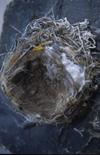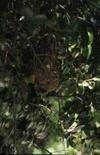Submitted by Rainie on
The intermingling cycle of materials discarded by one member of a community and utilized for living by another became strikingly clear when my husband brought me two more nests from our garden. One was loosely woven and saucer-shaped, made of crossed sticks, grass, stems, and discarded dental floss. It was found near the ground on a horizontal branch, perhaps constructed by a male and female Mourning Dove. At first glance the other nest looked like a vintage purse crocheted from chenille, the color of serpentine. Woven by a male and female Bushtit, the pendant shape resembled a pouch, or sock. Closer observation revealed cocoons, lichen, flowers, moss, and bits of lint from my clothes dryer, all bound together with spider silk. Another pouch-like nest of identical dimension and substance was located a few days later in a Pittosporum ‘Silver Sheen’ next to the house. I noticed the second, hidden, nest only when the uppermost branches of the shrub began quivering with life, as a female Bushtit entered the front aperture of this hanging pocket enclosure.
From my neighbor I have learned that some birds go about their business prudently, undeterred by the fact that humans have built a house or two in their district. A ringing telephone interrupted dinner, when the woman next door called asking for help to investigate an unusual noise in her house. Aided only by flashlights and our curiosity my husband and I searched her home and discovered that a barn owl was nesting in the chimney. Typically they choose caves, buildings, or cavities to nest. We determined that the owl could not have been there long. Its call resonated through the metal lining creating an eerie and at first unidentifiable quality to the bird’s voice. The chimney must have appeared to be a perfectly reasonable place to nest, something akin to a hollow tree trunk. The night air was brisk, prompting our neighbor to desire a fire in her hearth. By gently teasing a bed sheet up and through the flue we encouraged the inhabitant to exit the top opening. The owl was seen at dusk several nights later, swooping down into the pasture from an abandoned barn fifty yards away.
On another occasion I saw a rather elaborate ritual involving a dusty unused bicycle helmet that sat atop the water heater casing near my back door. Two Bewick’s Wrens came to inspect it, darting one at a time, in and out of the helmet then alighting side by side on the branch of an adjacent Japanese maple, their heads bobbing about as if in dialogue over the suitability of this contraption as a home. It must have proved satisfactory as both birds began carrying twigs, grass, and feathers into the helmet opening, where eggs were soon laid. I observed the birds every day for fourteen days, as the male bird hovered near the helmet house bringing food while the female incubated the eggs, and each day afterward as both tended their young. Eagerly, I waited for the babies to fledge so that I might examine closely the materials used for building. At last with nest in hand I inspected the contents, and discovered twigs, small feathers, bits of yellow twine from the nursery field, green dental floss, and long coarse hairs from the mane of my daughter’s pony. Lining the depression was gray wool fuzz, from an old sweater that hung on a fencepost. I placed the nest on my mantelpiece and left the bicycle helmet undisturbed in hopes that it would again become the home of a Bewick’s Wren.
There have been a myriad of nests found in the garden, made with an equally remarkable collection of materials. One made by a Plain Titmouse was composed of grass, pine needles, forbs, and woven with strands of reddish hair that looked to be from my hairbrush. A rather large nest of unknown origin was discovered toppled to the ground. It was created from oak leaves, spent seed heads, spider silk and lined with matted animal fur from the neighbors pet-grooming brush. A few twigs jutted from its sides along with pieces of orange yarn and a knotted bundle of twine. A tiny chocolate-brown nest made entirely of ironwood leaves was found in the crook of a tree. This collection is now going to my sister, who teaches young deaf children, and looks for opportunities to introduce them to the natural world. Packed in a brown cardboard box, the nests are en route to her students, as I look forward to discovering the repertoire of resources gleaned from the garden by next years nesting birds.
Rainie Fross June 2002






